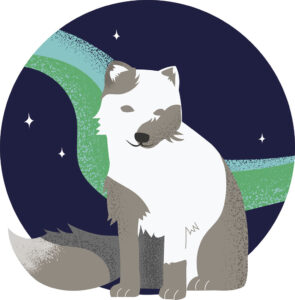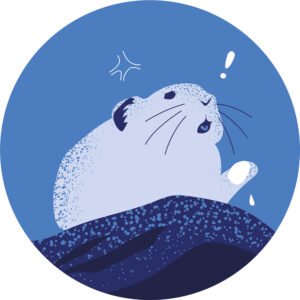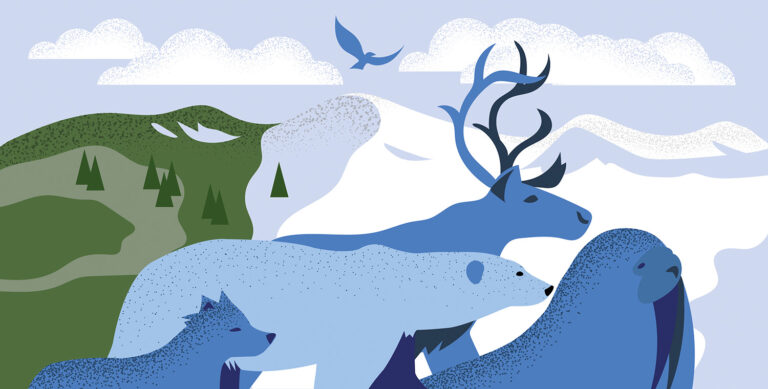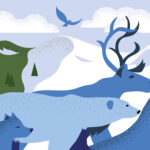How Animals Strive to Adapt to a Rapidly Changing Climate
By Somaya Salama
Why do geese have beaks instead of teeth? Why do male deer grow antlers, only to lose them? Why do birds migrate in the winter? It’s all about adaptation. Every animal goes through adaptations, which can mean changes in appearance or behaviour that are more suitable to their environment. Adaptations happen very gradually over generations as the environment changes. Sadly, because of global warming, habitats are changing so quickly that animals don’t have enough time to adapt effectively. This causes a number of problems for both the animals and their environment.
Animals adapt, physically and behaviourally, as a means of survival, so they can reach their main food sources, fend off predators, and survive seasonal changes in the weather. Whether we realize it or not, we see the results of animal adaptation all the time, like when carnivorous animals rip flesh with their sharp canine teeth or when prey travel in herds because there is strength in numbers. Survival isn’t the only outcome, however; when animals develop new adaptations, they also develop new relationships with their environments. The monarch butterfly is a great example. Its larvae feed on milkweed leaves, which have a strong, distasteful odour and are poisonous. The monarch adapted so that it is able to digest this poisonous plant and because of its smell, predators keep away from the butterfly and its eggs.
Migration is another common result of behavioural adaptation that helps animals, including insects, to survive. Monarch butterflies migrate 4,000 kilometres from Canada to Mexico every fall to avoid winter. For many animals, particularly in Canada, the northern winter weather and cold temperatures present a tough challenge to which they are forced to adapt. For example, thinhorn sheep in the Yukon gather in communal herds in the winter to keep warm and, due to the greater amount of sunlight they receive in the fall, spend most of their time grazing on south-facing hillsides to maximize their access to food and warmth.

Moving northeast to Nunavut, the Arctic fox has seen many adaptations that help it survive winter, such as its fur turning white as cold weather approaches. This camouflage helps the fox hunt prey and avoid predators and, because white fur lacks pigment, it makes a great insulator because there is more room for warm air. Like several other northern animals, the Arctic fox has also adapted to have a thicker body than its southern cousins. This follows an ecogeographical rule, formulated by Joel Asaph Allen in 1877, known as Allen’s Rule, which states that “animals with a greater surface area, long limbs, ears, tails, and snouts, lose more heat than those with compact bodies and stubbier appendages.”
In the Yukon, the tundra muskox has survived since the ice age because of its ability to adapt. The main reason it out-survived its cousin, the helmeted muskox, has to do with it being both smaller and shorter. Having a slower metabolism also helps as it allows the animal to enter torpor, or “temporary hibernation,” which is a state of decreased activity that allows animals to conserve energy, increasing their chances of surviving unfavourable conditions.
As we know, climate change has been affecting the environment for years. Seasonal patterns are becoming irregular and many habitats are being lost due to global warming. The genes that help animals survive develop gradually: the animals that gain those new traits have more offspring than animals that do not adapt, and offspring with these successful genes have more offspring. Then, after years of this natural selection, those new genes become dominant. For this reason, when the climate changes at the rate it is now, animals find it difficult to adapt to these conditions and, given the time required, impossible to develop the traits to improve their chances of survival.
The effect is easy to see with the monarch, which migrates in the winter because of the decreasing temperature and a lack of milkweed—its primary food source. Now that average temperatures are warming, the butterfly’s usual migration pattern is gradually falling out of sync with the blooming of the milkweed. Along with the dwindling of the milkweed’s habitat due to drought, heat, and herbicides, this has caused the monarch population to decrease by 95 per cent over the last two decades. For animals in the Arctic, these effects are all the more drastic, with issues including loss of habitat and food to new competition due to range shifting, which is when the limits of a given animal’s habitat move because of physical changes in the environment. In Nunavut, indigenous species such as caribou, Arctic foxes, walruses, and polar bears are forced north to colder climates. The problem is that there aren’t many colder places to go.

Alongside the fact that these Arctic creatures are unable to travel farther north, invasive species from the south are moving in. Beavers are a great example of this invasion. Their habitat is the wetlands, but they’ve been moving into the Arctic tundra because increasing temperatures and melting ice are creating a habitat similar to the wetlands. Such invasive species carry unfamiliar diseases that can infect the berries and herbs that many of the indigenous species eat. In the Northwest Territories, the collared pika—a cousin of rabbits and hares—is also in danger. Warmer temperatures are affecting the mountain tops where the collared pika resides, resulting in less of the snow that the animal uses as insulation for its nests. Without this protection, they are exposed to extreme temperatures, which impacts their ability to survive in their natural habitat. Unfortunately, the collared pika can’t do much to increase its survivability, as the mountain tops are about as cold as the nearby regions get.
Just like butterflies, foxes, and pikas, humans are animals too. Our adaptations can look different though. Migration isn’t always a possibility or a solution for many people facing the effects of climate change. Our ability to adapt relies heavily on our relationship to the environment. To help ensure our own survival, we need to look out for other animals as well as the environment. Of course, we can always enforce environmentally friendly practices such as reducing water use, using less electricity, recycling, and composting, but that can only take us so far. We all need to learn from the ways Indigenous communities have fought against climate change, as they were some of the first to feel its effects. Many Indigenous cultures have practices that already help animals and the environment thrive, like making the most of resources, giving back to the environment, and prioritizing understanding of its needs. This is the result of ancestral knowledge that has been passed down for generations.

As the effects of climate change worsen, many Indigenous communities are working together to combat its effects. A coalition of Indigenous groups in Nunavut has been working to reduce the region’s dependence on diesel generators by transitioning towards renewable energy. Indigenous Climate Action (ICA), another coalition of Indigenous communities across Canada, is actively fighting against climate change. Their most recent projects focus on cleaning up toxic tailings, such as the results of the Imperial Oil disaster in northern Alberta. Toxic tailings occur when industrial wastewater is leaked from tar sands into nearby bodies of water, contaminating the environment. ICA has been focused on working with and for the communities affected by the Imperial Oil disaster, which include the Mikisew Cree, the Athabasca Chipewyan and Fort McKay First Nations, the Fort Chipewyan Métis, and others who live and rely on the water and land for drinking water, food, and medicine. In response, the community members in Alberta are focused on repairing the damage done to the land and the people, which involves demanding accountability from the companies responsible and conducting proper investigations of the environmental impact. Reversing the effects of environmental damage involves working together for a solution—not just with other humans, but with the land itself.
Eriel Deranger, a founding member of ICA, says, “Real climate solutions are decolonial climate solutions because they’re taking us back to reconnections with the land, to being on the land, to reconnecting with that intimate understanding of how not just to live and survive on the land, but how to adapt and change with it.” The knowledge Indigenous communities have passed down for generations has helped Canada fight climate change effectively. Studies show that when Indigenous Peoples have the right to govern their land, biodiversity increases and forests are protected.
Ultimately, animals need to adapt to survive in their environment. Humans need to allow that process to happen naturally and reverse the ways in which we have hindered that survival by contributing to climate change. With the help of human intervention, these animals may be able to get back to their normal surroundings and adaptations before it’s too late.

